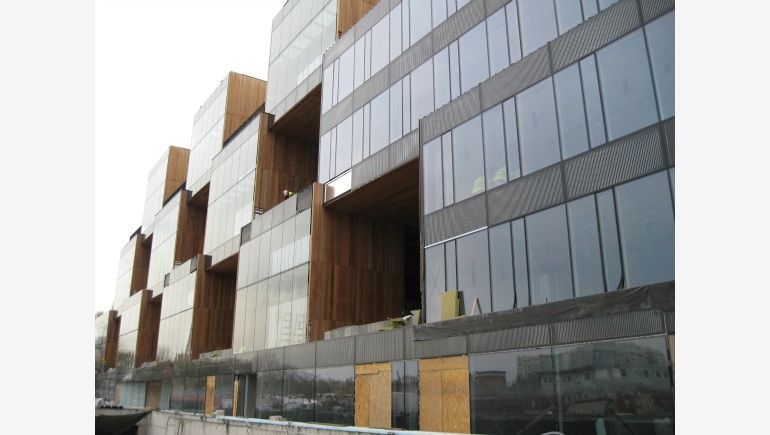In the first place Allegro Group will move into the seven-storey building with three underground tiers. Interiors of Pixel were designed for needs of Allegro Group - first of the five Klaster Grunwaldzka offices.
Elevation of the building was designed by JEMS Architekci and compels interest by its unusual form, mainly its inner "pixelled" part, designed in a system of cubes placed one on the other. Monotony of office plane is interrupted by systematically retracted cubes by two tiers. Terraces of cubes are panelled in Canadian cedar wood neighbouring alternately with double glass facades.
Second layer of glazing, isn't hermetical on purpose, plays an insulating and protecting function, protecting against the superabundance of heat inside the rooms helping the ventilation system in the building, guided centrally within BSM. Additionally, glazed wall of the cube make sun light penetrating deeply the building, lighting all rooms with a glass facade. By this, a building is lightened, and at the same time guarded against overheating due to a thermoinsulation divider.
Terraces of Pixel are not only designed for decoration purposes. They're also a workplaces equipped with benches and pots with natural greenery, what is supposed to reflect its deformalized character. Open spaces dominate in interiors as well as duct panels with accordion walls. An accordion glass wall was mounted on the ground floor which is a sensation on the local office market. All this makes that Pixel office can be undoubtedly qualified to A class offices.
Green
The aim of the investor was to get a BREEAM certification due to which a building will be signed in the conception of green buildings since a project stage.
Sustainable conception of effective using of Klaster buildings doesn't aim building of higher offices, even if it was possible in the location - claims Michał Włodarczyk from Garvest Real Estate - We wanted to use the potential of the place, so as not to generate in the neighbourhood causing traffic or blocks, lowering a comfort of working from the investment and life level of inhabitants.
Among other things, investors in agreement with neighbours decided to build a half kilometre of road available for public use. This idea got an acceptance from the Authorities. It's one of the first investor's initiatives of this type in Poznan.
A green element, both from the name and in the reality, is a garden with hornbeam hedges designed on the roof. Despite of the undoubted aesthetic function it has also a capability to stop the overflow of storm water which is a problem for urban sewage system during the heavy rains. Office complexes with a large roof space (as Klaster) generate quantity of water, which local system can not take. Standard of Klaster green offices is not only stopping this water but using it to watering greenery in the forecourt equipped only in cycle paths.
That last one element points out another way of thinking of designers who established creating, despite 400 parking spaces underground, also a full communication links for cyclists. They can use the check-room, changing-room, shower and drying room before going to work in the building.
Klaster is not just a place to which you come to work. It's also a centre surrounded by services such as private nursery, fitness centre or consulting rooms to help employees.
Investment in savings
As representative of investor says, "Scandinavian" thought transfers also on concrete rawness, on purpose unpainted interior walls, modern vinyl floor coverings and high quality of BSM system. This system serves i.a. four pipe fan coil, significantly modifying heating system in the building. It's similar with the good class lightning which is not typically energy-saving, in connection with BSM it lets on significant low usage of electric energy. Five high-speed lifts is one reason for which a building is signed in the A class offices, despite the fact that it is not situated in the city centre.
Those solutions influence the costs of usage and complex service, which according with the postulates are supposed to be lower by 20% from standard one. Taking into account the standard lease rate on the Poznan's market, leaseholders can think about real, high savings run-of-year.
Elevated standards are not investor's fantasy, but his conscience investment in the future in which for 20 or 30 years competitive will be only those building which today are the state-of-the-art. And because of those reasons, and not only due to the architecture, Pixel could be built in Berlin or Paris.
In the short run, when we think about the income in the perspective of few years the cost of this investment could be lowered by applying cheaper solutions - says Włodarczyk - but then Poznan's office market will be for sure more developed and then a competitive quality advantage will count.
What's now - according to the representative of investor - there is not a real market of office space in the capital of Greater Poland, and most of the average companies and those small ones function in not adjusted to this aim office rooms ad in the buildings next to which there is lack of parking spaces.
Another 50 000sqm will enter on the Poznan's market of office spaces after the end of the whole investment. It's an impressive number taking into account the fact that global supply of the city amounts only to 300 000sqm.



